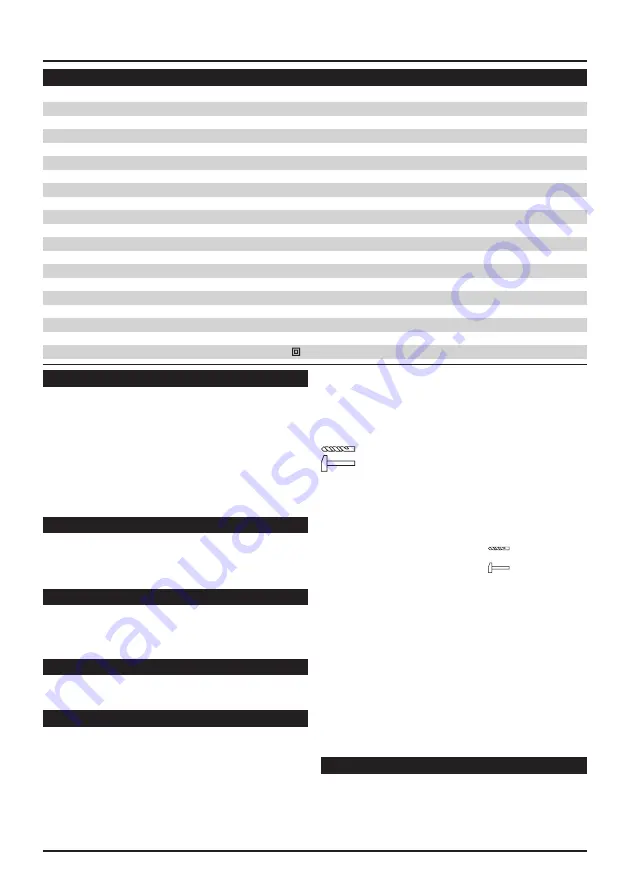
English
11
Technical data
Rotary hammer
Typ
EKV 20 E
Voltage.
30.V
Frequency.
50–60.Hz
Input.power.
550.W
No-load.speed.
0–1.000.min
–1
Speed.under.load.
0–730.min
–1
Electronic.speed.control.
Right/Left.rotation.
No-load.impact.rate.
0–4.950.min
–1
Impact.energy.
.0.J
Tool.holder.
SDS-Plus
Drilling.–.ø.max.,.full.drill:
.
Steel.
13.mm
.
Wood.
30.mm
.
Concrete.
0.mm
Screw.screws-.ø.max.
.
Wood.
6.mm
Weight.
..kg
Protection.class.
II./
Description of the device
1 ............ Chuck head
2 ............ Locking sleeve
3 ............ Ventilating apertures
4 ............ On/off switch with speed control
5 ............ Locking button for on/off switch
6 ............ Function change over switch
7 ............ Switch for change of rotating direction
8 ............ Additional handle
9 ............ Adapter with thread for chuck
10 .......... Chuck
11 .......... Protective cover
Not all of the accessories illustrated or described are included as standard
delivery.
Application
Electropneumatic hammer drill is the device specified in particular for im-
pact drilling into concrete, stone and masonry, further on, for impact-free
drilling and screwing into wood, metal and plastics.
This electropneumatic hammer drill may be used for the purposes above
within the scope determined by the manufacturer.
Double insulation
To ensure maximum safety of the user, our tools are designed and built to
satisfy applicable European standards (EN standards). Tools with double in-
sulation are marked by the international symbol of a double square. These
tools must not be grounded and a two-wire cable is sufficient to supply
them with power. Tools are shielded in accordance with EN 55014.
Supplementary handle assembly
Before any interference to the tool, disconnect the supply cable first. Use
the hammer only with supplementary handle (10). Mount the handle to the
fastening neck and secure with revolving grip.
Putting into operation
Connect only to a single-phase alternating current power network with
voltage marked on the nameplate. It is possible to connect the tool even to
outlets without a protective contact, as this is a class II appliance.
Check, if the plug type corresponds with type of the outlet.
Switching ON and OFF
To switch the tool on, push the switch (4) and hold. The hammer switches
off as soon as you release the hold of the switch.
Rotation regulation
You can continuously change rotations with the switch (5). Push the switch
slightly and the hammer will start rotating slowly. The stroger you push at
the switch, the faster the rotation.
Function switch
The change-over switch of functions (6) has two positions:
= drilling,
= impact drilling.
Change the functions in the rest position only. Swivel the switch (6) simply
to the requested position.
The hammer drill gearbox will be switched to the selected position after
depressing the switch (4) and/or as soon as the hammer drill is started.
Drilling and impact drilling
For drilling or screwing:
switch the function switch (6) onto the symbol
.
If you want impact drilling:
switch the function switch (6) onto the symbol
.
Notice: When impact drilling, do not change the speed to the left to
prevent drill damage. You can switch the speed to the left only if the
drill is jammed and you want to put it out of the hole more easily. Use
only and exclusively the recommended drills with the SDS-Plus shank
for impact drilling.
You cannot use the impact drills with the cylindrical shank specified for
common chucks (quick-acting chucks or chucks with handle) for this elec-
tropneumatic hammer drill.
Direction switch
Use the direction switch (7) only if the hammer drill is at rest. Grip the speed
switch (7) from both sides.
Rotation to the right:
Move the speed switch (7) to „R“.
Rotation to the left:
Move the speed switch (7) to „L“.
Important! Swivel the speed switch (7) as far as the stop on the mo-
tor guard, until you can hear a click. If the speed switch is in the in-
termediate position between „R“ and „L“, the hammer drill cannot be
started.
Inserting and removing bits
Drilling and chiseling bits are inserted to and removed from the chuck head
(1) without a key.
Inserting bits
Before any interference to the tool, disconnect the supply cable first.
Clean the shank of the bit and grease it slightly.
Summary of Contents for EKV 20 E
Page 3: ...1 2 3 4 5 6 7 8 9 10 11...
Page 16: ...16 1 2 a RCD RCD 3 a 4 a 5 a...
Page 26: ...26...
Page 27: ...27...








































